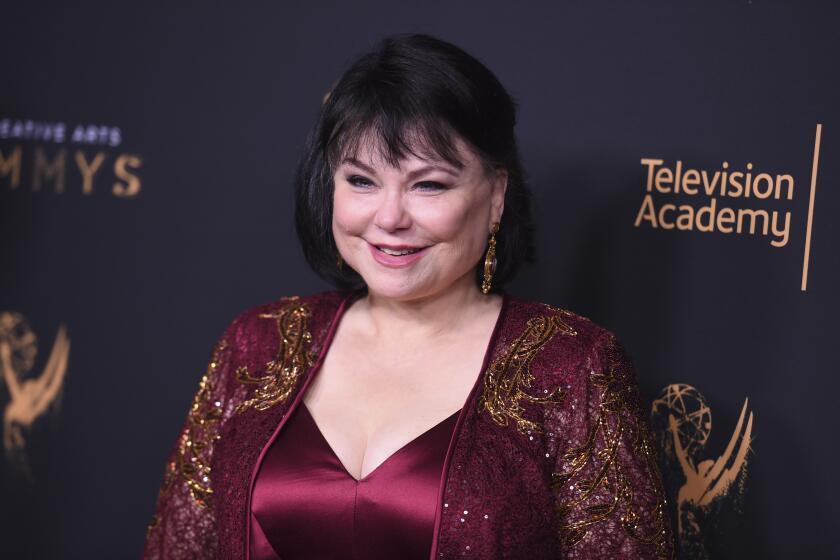The creators of ‘Tiny Shoulders: Rethinking Barbie’ on remaking America’s doll just before #MeToo
She’s too thin, too tall, too blond. And now, too fat.
Poor Barbie.
Since her birth nearly 60 years ago, the 11½-inch doll has been a repository for every impossible expectation thrust on womankind. She’s weathered the nuclear age, the sexual revolution, a feminist backlash and the advent of Bratz Dolls with a neutral smile and perky bustline.
“Tiny Shoulders: Rethinking Barbie” takes a look at the cultural weight placed upon Barbie’s forever-scrutinized frame and the challenges of keeping the American icon relevant in the age of fat-shaming, #MeToo and changing gender ideals. The 93-minute documentary, now streaming on Hulu, goes behind the scenes at Mattel in 2016, on the eve of a seismic shift for America, for the brand and for the doll at the center of it all.
“We have a very complicated relationship with our own femininity, and it’s not just us individually,” said the film’s writer and director, Andrea Nevins. “Society still has a very complicated and unsolved idea of what women should be today. That’s captured in this doll. She carries a lot on her tiny shoulders. I think we all do.”
From role model to patriarchal shill to lightning rod, it’s a lot to deal with, even for a small piece of plastic. Nevins approaches her subject with a gravity and depth one might find surprising in a film centered around toy-store merchandise.
Far from child’s play, “Tiny Shoulders” explores what Barbie has meant to generations of women, and men, in interviews with historians, feminist leaders such as Gloria Steinem and Roxane Gay, and the female teams at Mattel now in charge of rethinking Barbie for the 21st century.
Nevins got the idea to make the film after a friend who worked at Mattel kept telling her “how excited she was to go to work everyday because she was with a bunch of really strong, interesting women, debating who Barbie should be for the next generation,” said Nevins. “Her work meant puzzling through who we are right now, where we’ve come from and where we should be going as women, what we should be inspiring girls to be and do. That in itself seemed to me a really interesting way to look at womanhood today.”
Throughout the film, other Mattel employees, including chief designer Kim Culmone and the company’s PR chief Michelle Chidoni, represent two ends of the challenges of making Barbie more relevant and representative. They are on the verge of launching a “curvy Barbie,” who comes in many shades, a move that they hope will revive flagging sales and reframe Barbie’s place in girls’ hearts and their mothers’ collective psyches.
America seems poised to elect its first female president as the cameras go inside Mattel’s El Segundo headquarters, and the #MeToo movement is just around the corner (“We were watching the women’s march,” said Nevins, “and we all screamed when we saw their hats. They were Barbie pink!”).
In one scene, the Mattel creative team watches a test group to see how they’ll react to a fuller-figured version of Barbie. The effort to launch this new doll is called Project Dawn.
But like Desert Storm or Shock and Awe, Project Dawn also works as a strategic name for an uphill battle. As they watch girls play with the doll through a two-way window, the team winces as they face the tough realities of trying to keep Barbie real.
An interviewer in the room asks what they think of the voluptuous update.
“She looks different,” says one child.
“Why?” asks the adult.
“Her legs are different,” answers the girl.
“Is that good?” inquires the adult.
“No. She’s fat,” giggles the girl. “She’s a fatty.”
Encouraging a healthier body image while pretending that size doesn’t matter is an impossible tightrope walk, and “Tiny Shoulders” captures that dichotomy wonderfully in behind-the-scenes debates at Mattel, among feminists and Barbie fans, about what the doll should symbolize versus what realities she should reflect.
“It was not easy getting in [to Mattel],” said producer Cristan Crocker. “It took nine months of negotiations to even take our independent cameras through the doors of the design center. We would get in and want to stay longer, and remind them of what we were doing and re-pitch it. It is just not in their DNA, or any toy company’s, to be that open and that vulnerable.”
For those who aren’t Barbie aficionados but grew up dressing them in GI Joe clothing, cutting their hair in unfortunate bobs or drawing on Magic Marker lipstick, “Tiny Shoulders” explores a rich history that’s both fascinating and surprising.
No, she was not created by a bunch of pipe-smoking men who expected their meatloaf on the table at 6 p.m. Barbie was created by a woman, Mattel co-founder Ruth Handler, who named the doll after her daughter. The first models, which were blond and brunet, flew off the shelves when they were released in 1959, despite warnings from her male colleagues that a doll with breasts would never sell.
Even then, Barbie caused a stir. All other dolls on the market were baby dolls, meant to teach girls to nurture. Barbie was a single woman, not a mother, designed to give them another idea of what their futures might look like.
Handler designed a career Barbie line in the 1960s, which was in itself revolutionary. Forget “Mystery Date,” you can be the flight attendant, the business woman in a suit, the astronaut. Old TV ads shown in the documentary blow up every argument that Barbie was initially another post-war ploy to push women back into domestic roles.
Changes in culture, leadership and the politics outside’s Mattel doors made Barbie’s trajectory a very different one than imagined by her creator. And now, “Tiny Shoulders” explores the many lives Barbie has lived.
“I knew, no matter what, Barbie was going to be an interesting way to look at where we are now,” said Nevins. “I’d seen the progress that allowed my mom to have a full-time career but also the images in society that were setting us back as women. I could see those waves, and that Barbie had been riding every one of them.”
‘Tiny Shoulders: Rethinking Barbie’
Where: Hulu
When: Any time, starting Friday
Rating: TV-14 (may be unsuitable for children under the age of 14 with an advisory for sexual content)
More to Read
The complete guide to home viewing
Get Screen Gab for everything about the TV shows and streaming movies everyone’s talking about.
You may occasionally receive promotional content from the Los Angeles Times.







